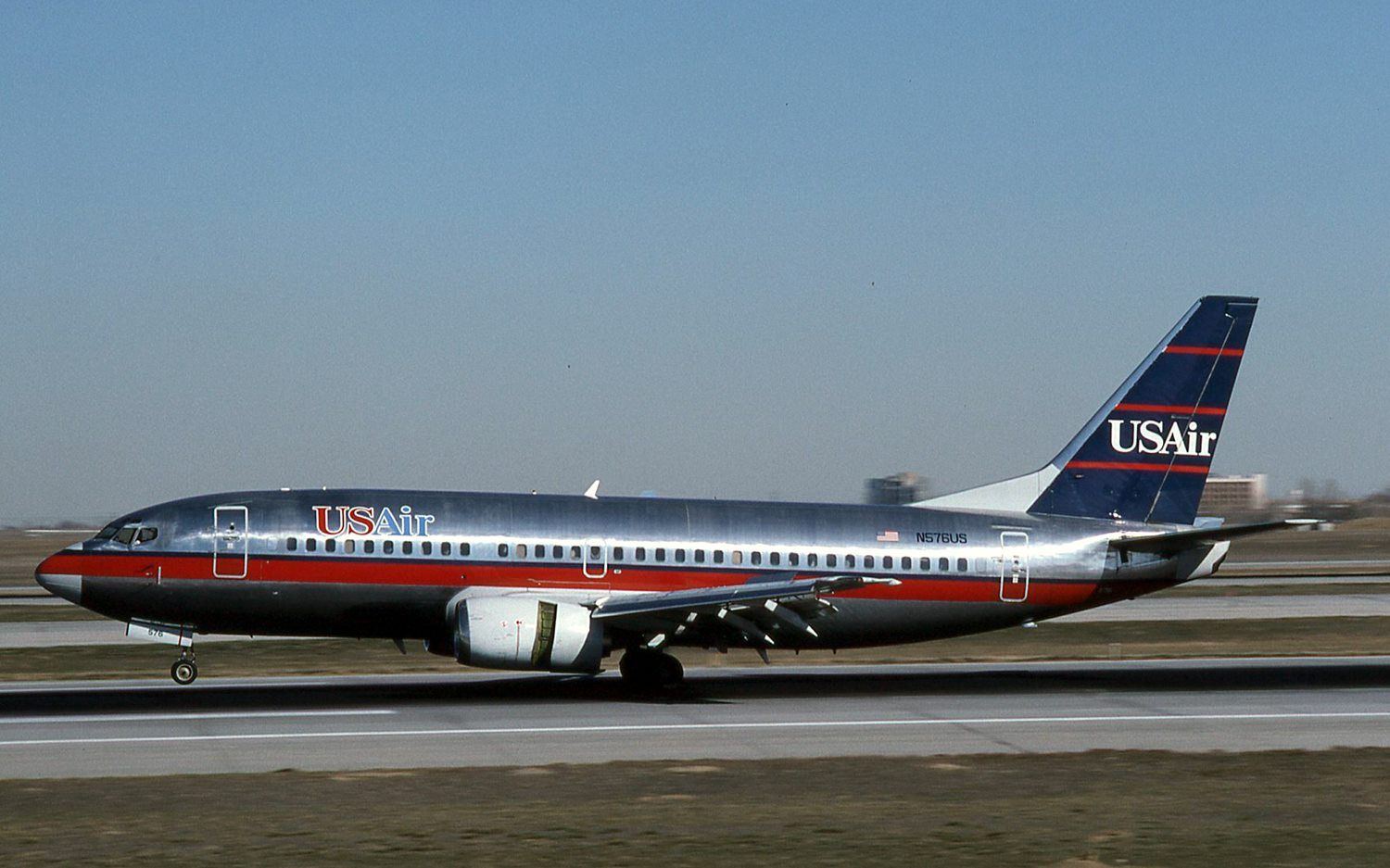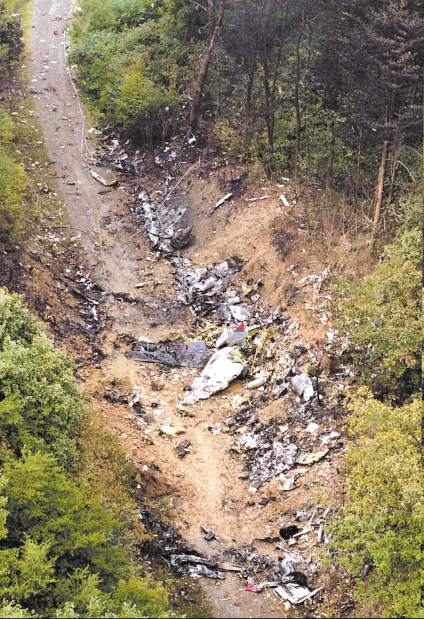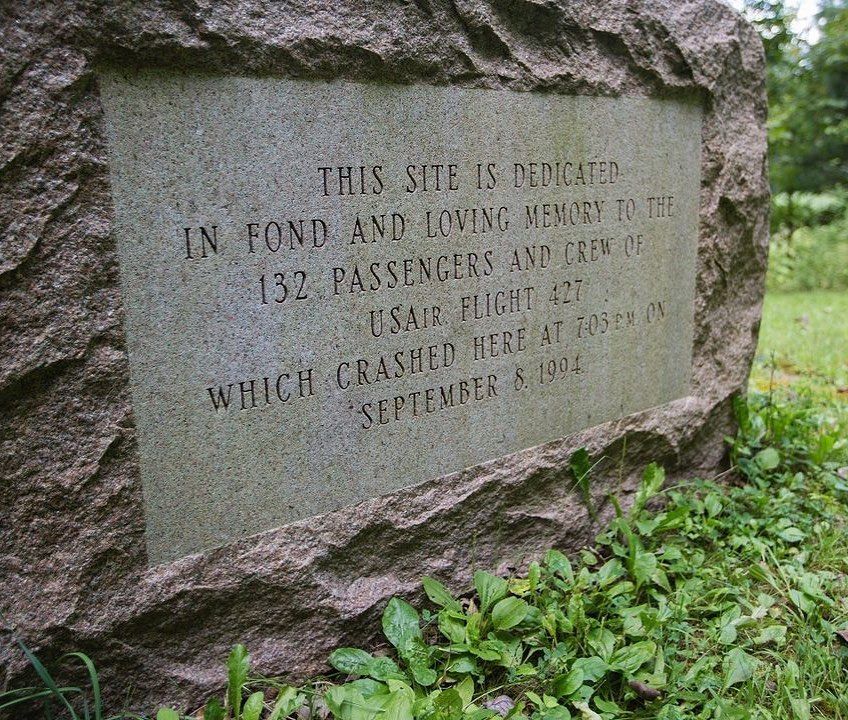8 September 1994 - USAir 427
USAir Flight 427, a Boeing 737-3B7, registration N513AU, was approaching Pittsburgh runway 28R when ATC reported traffic in the area, which was confirmed in sight by the first officer. At that moment the aircraft was levelling of at 6000ft (speed 190kts) and rolling out of a 15deg left turn (roll rate 2deg/sec) with flaps at 1, the gear still retracted and autopilot and auto throttle systems engaged.
The aircraft then suddenly entered the wake vortex of a Delta Airlines Boeing 727 that preceded it by approx. 69 seconds (4,2mls). Over the next 3 seconds the aircraft rolled left to approx. 18deg of bank. The autopilot attempted to initiate a roll back to the right as the aircraft went in and out of a wake vortex core, resulting in two loud "thumps". The first officer then manually overrode the autopilot without disengaging it by putting in a large right-wheel command at a rate of 150deg/sec. The airplane started rolling back to the right at an acceleration that peaked 36deg/sec, but the aircraft never reached a wings level attitude.

At 19.03:01 the aircraft's heading slewed suddenly and dramatically to the left (full left rudder deflection). Within a second of the yaw onset the roll attitude suddenly began to increase to the left, reaching 30deg. The aircraft pitched down, continuing to roll through 55deg left bank. At 19.03:07 the pitch attitude approached -20deg, the left bank increased to 70deg and the descent rate reached 3600f/min. At this point, the aircraft stalled.
Left roll and yaw continued, and the aircraft rolled through inverted flight as the nose reached 90deg down, approx. 3600ft above the ground. The 737 continued to roll, but the nose began to rise. At 2000ft above the ground the aircraft's attitude passed 40deg nose low and 15deg left bank. The left roll hesitated briefly, but continued and the nose again dropped. The plane descended fast and impacted the ground nose first at 261kts in an 80deg nose down, 60deg left bank attitude and with significant sideslip.
After the longest investigation in aviation history—more than four and a half years—the concluding statement said: The National Transportation Safety Board determines that the probable cause of the USAir flight 427 accident was a loss of control of the airplane resulting from the movement of the rudder surface to its blowdown limit. The rudder surface most likely deflected in a direction opposite to that commanded by the pilots as a result of a jam of the main rudder power control unit servo valve secondary slide to the servo valve housing offset from its neutral position and overtravel of the primary slide.
The NTSB concluded that similar rudder problems caused the previously mysterious 3 March 1991 crash of United Airlines Flight 585, and the 9 June 1996 incident involving Eastwind Airlines Flight 517, both of which were Boeing 737s. As a result of the investigation, pilots were warned of and trained how to deal with insufficient aileron authority at an airspeed at or less than 190 knots (218 mph, 354 km/h), formerly the usual approach speed for a B737. Four additional channels of information—pilot rudder pedal commands—were incorporated into flight data recorders, while Boeing redesigned the rudder system on 737s and retrofitted existing craft until the affected systems could be replaced. The United States Congress also required airlines to deal more sensitively with the families of crash victims.
US Airways 427 is no longer a valid flight number on US Airways as of September 2009.
Flight 427 was the second fatal crash in a little over two months at the company (the other being USAir Flight 1016 at Charlotte-Douglas Airport in July, 1994). Some feel these crashes contributed to the financial crisis USAir was experiencing at the time.

Transcript of the Cockpit Voice Recorder (CVR)
Legenda
CAM-1 = Captain
CAM-2 = First Officer
CAM-3 = Cockpit Area Mike (cabin sounds and flight attendants)
RDO-1 = Radio Communications (Captain)
APP: Pittsburgh Approach
CAM-3: They didn't give us connecting flight information or anything. Do you know what gate we're coming into?
CAM-1: Not yet.
CAM-3: Any idea?
CAM-1: No.
CAM-3: Do ya know what I'm thinkin' about? Pretzels.
CAM-1: Pretzels?
CAM-3: You guys need drinks here?
CAM-1: I could use a glass of somethin', whatever's open, water, uh, water, a juice?
CAM-2: I'll split a, yeah, a water, a juice, whatever's back there. I'll split one with 'im.
CAM-3: Okey-dokey. Do you want me to make you my special fruity juice cocktail?
CAM-1: How fruity is it?
CAM-3: Why don't you just try it?
CAM-2: All right, I'll be a guinea pig.
CAM-3: [Sound similar to cabin door closing]
The crew recieve instructions to reduce speed to 210kts, maintain FL100 and contact Pittsburgh Approach at 121.25.
CAM-1: Two ten, he said?
CAM-2: Two ten? Oh, I heard two fifty ...
CAM-1: I may have misunderstood him.
Pittsburgh Approach asks Flight 427 to turn left heading 100.
CAM-3: [Sound of cockpit door opening]
CAM-3: Here it is.
CAM-1: All right.
CAM-2: All right. Thank you. Thank you.
CAM-3: I didn't taste 'em, so I don't know if they came out right.
CAM-1: That's good.
CAM-2: That is good.
CAM-3: It's good.
CAM-2: That is different. Be real good with some dark rum in it.
CAM-3: Yeah, right.
APP: USAir 427, Pittsburgh Approach. Heading 160, vector ILS Runway 28 Right final approach course speed 120.
CAM-2: What kind of speed?
RDO-1: We're comin' back to 210 and, uh, one sixty heading, down to ten, USAir 427.
CAM-1: What runway did he say?
CAM-1: It tastes like a...
CAM-2: Good.
CAM-1: There's little grapefruit in it?
CAM-3: No.
CAM-2: Cranberry?
CAM-3: Yeah. You saw that from the color.
CAM-1: Else is in it?
CAM-2: Uh, Sprite?
CAM-3: Diet Sprite.
CAM-2: Huh.
CAM-3: And I guess you could do with Sprite. Probably be a little better if you do.
CAM-1: Yeah. There's more?
CAM-3: One more.
CAM-2: Ah.
CAM-3: You got it.
CAM-2: Huh?
CAM-3: Cranberry, orange, and Diet Sprite.
CAM-2: Really nice.
CAM-3: It's different...
CAM-1: I always mix cranberry and the grapefruit. I like that.
CAM-3: Okay, back to work.
CAM-2: Okay.
CAM-3: [Sound similar to cockpit door opening and closingl
CAM-2: I suspect we're going to get the right side.
APP: USAir 427 descend and maintain six thousand.
RDO-1: Cleared to six, USAir 427.
CAM-2: Oh, my wife would like that.
CAM-1: Cranberry, orange, and Sprite.
CAM-2: Yeah. I guess we ought to do a preliminary.
Pre-landing checks take place; Approach requests a left turn heading 140, and speed reduction to 190kts.
CAM-3: [Sound similar to flap handle being moved; sound of single chime similar to seat belt chime]
CAM-2: Oops. I didn't kiss 'em goodbye. What was the temperature? Remember?
CAM-1: 75.
CAM-2: 75?
PA: Seatbelts and remain seated for the duration of the flight.
PA: Folks, from the flight deck, we should be on the ground in about ten more minutes. Uh, sunny skies, a little hazy. Temperature ... temperature's, ah, 75 degrees. Wind's out of the west around ten miles per hour. Certainly 'ppreciate you choosing USAir for your travel needs this evening. Hope you enjoyed the flight. Hope you come back and travel with us again. This time we'd like to ask our Flight Attendants please prepare the cabin for arrival. Ask you to check the security of your seatbelts. Thank you.
CAM-3: [Seatbelt chime]
RDO-1 : Did you say Runway 28 Left for USAir 427?
APP: Uh, USAir 427, it'll be 28 Right.
RDO-1: 28 Right, thank you.
CAM-1: 28 Right.
CAM-2: Right, 28 Right. That's what we planned on. Autobrakes on one for it.
CAM-1: Seven for six.
CAM-2: Seven for six.
CAM-1: Boy, they always slow you up so bad here.
CAM-2: That sun is gonna be just like it was takin' off in Cleveland yesterday, too. I'm just gonna close my eyes. [Sound of laughter]. You holler when it looks like we're close. [Sound of laughter]
CAM-1: Okay.
APP: USAir 427, turn left heading one zero zero. Traffic will be one to two o'clock, six miles, northbound Jetstream climbing out of thirty-three for five thousand.
RDO-1: We're looking for the traffic, turning to one zero zero, USAir 427.
CAM-3: [Sound in engines increasing rpms]
CAM-2: Oh, yeah. I see the Jetstream.
CAM-1: Sheez...
CAM-2: zuh?
CAM-3: [Sound of thump; sound like 'clickety-click'; again the thumping sound, but quieter than before]
CAM-1: Whoa ... hang on.
CAM-3: [Sound of increasing rpms in engines; sound of clickety-click; sound of trim wheel turning at autopilot trim speed; sound similar to pilot grunting; sound of wailing horn similar to autopilot disconnect warning]
CAM-1: Hang on.
CAM-2: Oh, Shit.
CAM-1: Hang on. What the hell is this?
CAM-3: [Sound of stick shaker; sound of altitude alert]
CAM-3: Traffic. Traffic.
CAM-1: What the...
CAM-2: Oh...
CAM-1: Oh God, Oh God...
APP: USAir...
RDO-1: 427, emergency!
CAM-2: [Sound of scream]
CAM-1: Pull...
CAM-2: Oh...
CAM-1: Pull... pull...
CAM-2: God...
CAM-1: [Sound of screaming]
CAM-2: No... END OF TAPE.


